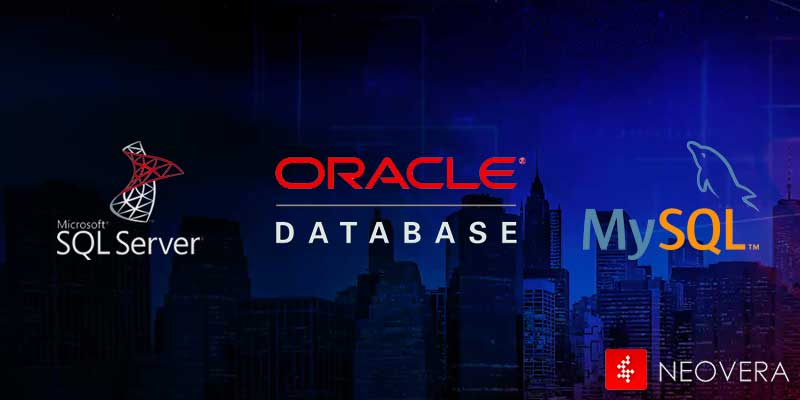MySQL vs. Microsoft SQL Server vs. Oracle: What Is the Right Relational Database Management System (RDBMS) for Your Business?

Relational Database Management Systems (RDBMS) are the most widely used database solution for companies and organizations in a number of different fields and industries. For those that may be unfamiliar with the term, an RDBMS is a database that uses a relational model to create groups of data put into tables. These tables are known as relations.
When it comes to choosing the right RDBMS for your organization, there are usually three databases you’ll need to compare: Oracle, MySQL, and Microsoft SQL Server.
How your organization is going to utilize the database and the programming software used is one of the most important factors in choosing the right RDBMS for your company. It may also come down to the knowledge of those in the IT department as well as their familiarity and experience with the different platforms.
Microsoft SQL Server
Microsoft SQL Server has come a long way since its initial release as Microsoft SQL Server 2000. Microsoft has consistently kept up with the latest technology by releasing frequent updates to SQL Server including SQL Server 2005, 2010, 2012, 2014, and most recently, 2019.
SQL Server began supporting XML with the 2005 release and included native support for OLE with the 2012 release. SQL Server 2014 had numerous new features including a suite of Business Intelligence data tools, improved disaster recovery solutions, and increased performance. SQL Server 2016 introduced the Stretch Database feature for archiving.
SQL Server 2019 introduces Big Data Clusters for SQL Server. The update also provides the additional capability and improvements for the SQL Server database engine, SQL Server Analysis Services, SQL Server Machine Learning Services, SQL Server on Linux, and SQL Server Master Data Services.
SQL Server Pros
- Works well with other Microsoft products
- Can now run on Linux
- Feature-rich Developer edition is free
- Relatively simple backup and recovery processes
- On-premises and cloud database support.
SQL Server Cons
- Can be expensive for enterprise features
- T-SQL program error handling is complicated
SQL Server Need-to-Knows
License
Languages Supported
PHP, Java, Ruby, Visual Basic, .NET, Python
Operating System
Oracle
Oracle is the most popular RDBMS, mainly due to its rich feature set, ability to scale along with technological advancements in intelligent automation. Oracle was also the first company to release its RDBMS for commercial use, and later the first company to release a commercial version of SQL that promoted the use of queries.
The most recent version of Oracle is known as “19c” and has a number of new features that increase security, enhance performance, including a new Competitive Analysis productivity app that allows you to create side-by-side comparisons that can be edited simultaneously by multiple users. Analytic views now allow you to ‘FILTER FACT’ and ‘ADD MEASURE’ keywords which allow users to include the ‘FILTER FACT’ keywords to filter the data accessed by the analytic view prior to aggregation.
Oracle databases are primarily used in large enterprise systems.
Oracle Pros
- Forecasted release schedule
- Out-of-the-box security features
- Performance, availability, and scalability
- Integration with on-prem and cloud deployments
- Supported on many platforms
Oracle Cons
- Many features require additional licenses that increase costs
- Oracle specialists are expensive
Oracle Need-to-Knows
License
Proprietary
Languages Supported
C, C#, C++, Objective C, Java, Ruby, Python, COBOL, .NET, Visual Basic
Operating System
Linux (Oracle, Redhat, SUSE, NeoKylin, IBM System Z), AIX, HP-UX, Windows, Solaris
MySQL
MySQL is an open-source database, which makes it quite a bit different than Oracle or Microsoft SQL Server, yet it has still managed to make its way into the enterprise space; for that very reason. As the Internet has grown to become an essential tool for business, the absolute necessity of building a company website has led to MySQL becoming the industry-leading database software for the management of databases connected to websites.
The latest release of MySQL (version 8.0) has several new features including the incorporation of a transaction data dictionary that stores information about database objects. In addition, Atomic DDL or (Atomic data definition statements) allows statements to combine data diction updates, storage engine operations and binary log write associated with a DDL operation into a single, atomic transaction.
There are also many security and account management enhancements added in MySQL 8.0 including restrictions on reuse of previous passwords, which has become a tremendous security risk in recent years.
MySQL Pros
- Available for free
- Large user base/Industry standard for web-based applications
- Supported on almost every platform
MySQL Cons
- Not as feature-rich as some other databases for unstructured data
- Restricted features for complex business logic
- Stability and performance in high concurrency processes
MySQL Need-to-Knows
License
C, C#, C++, Objective C, D, Ruby, Java
Languages Supported
C, C#, C++, Objective C, D, Ruby, Java
Operating System
Linux (Oracle, Redhat, CentOS), Solaris, Ubuntu, SUSE, Debian, Windows, MacOS, FreeBSD
Microsoft SQL Server vs Oracle vs MySQL
The Bottom Line
If you’re unsure about RDBMS which is the right fit for your company, contact Neovera to learn more and have an analysis done.
Neovera can also manage these databases for you, including security and disaster recovery, among other services. We specialize in managing databases for large firms and will ensure that your database is secure and performs at its best.
